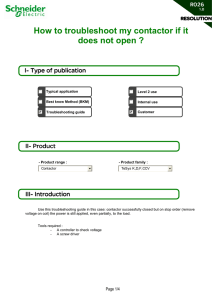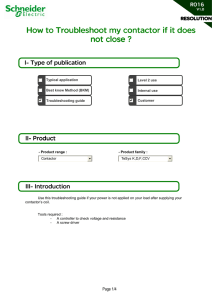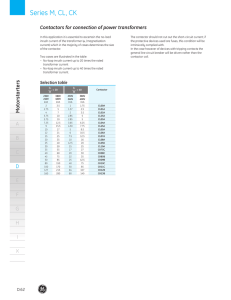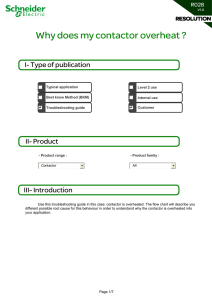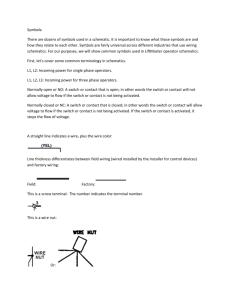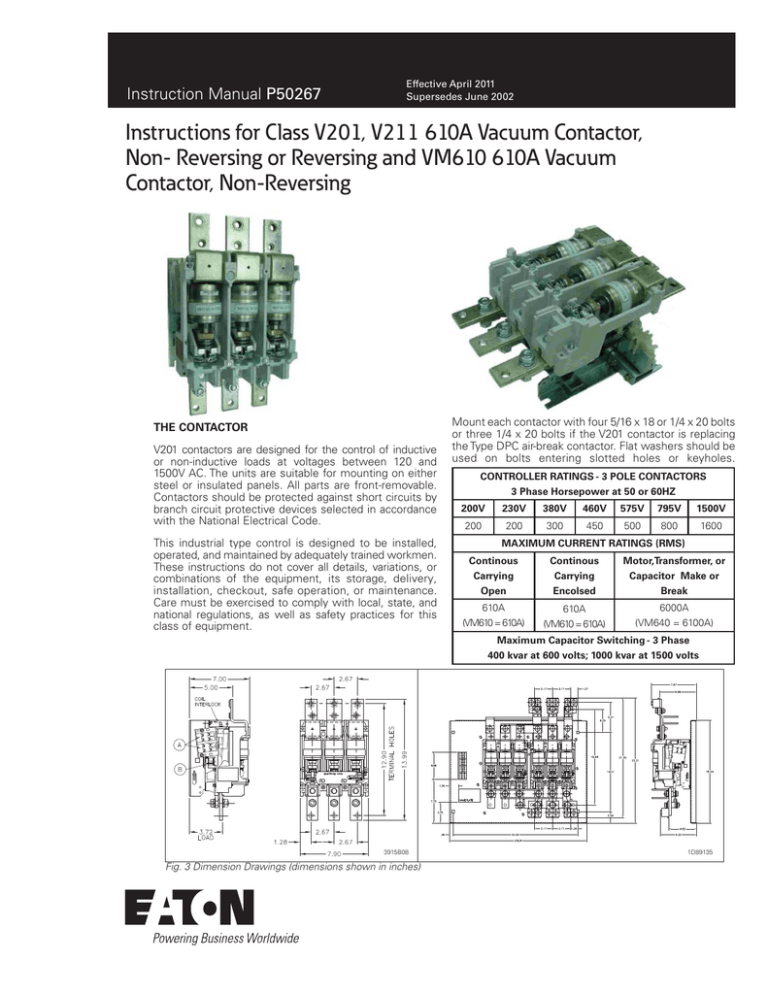
Instruction Manual P50267
Effective April 2011
Supersedes June 2002
Instructions for Class V201, V211 610A Vacuum Contactor,
Non- Reversing or Reversing and VM610 610A Vacuum
Contactor, Non-Reversing
THE CONTACTOR
V201 contactors are designed for the control of inductive
or non-inductive loads at voltages between 120 and
1500V AC. The units are suitable for mounting on either
steel or insulated panels. All parts are front-removable.
Contactors should be protected against short circuits by
branch circuit protective devices selected in accordance
with the National Electrical Code.
This industrial type control is designed to be installed,
operated, and maintained by adequately trained workmen.
These instructions do not cover all details, variations, or
combinations of the equipment, its storage, delivery,
installation, checkout, safe operation, or maintenance.
Care must be exercised to comply with local, state, and
national regulations, as well as safety practices for this
class of equipment.
Mount each contactor with four 5/16 x 18 or 1/4 x 20 bolts
or three 1/4 x 20 bolts if the V201 contactor is replacing
the Type DPC air-break contactor. Flat washers should be
used on bolts entering slotted holes or keyholes.
CONTROLLER RATINGS - 3 POLE CONTACTORS
3 Phase Horsepower at 50 or 60HZ
200V
230V
380V
460V
575V
795V
1500V
200
200
300
450
500
800
1600
MAXIMUM CURRENT RATINGS (RMS)
Continous
Carrying
Open
Continous
Carrying
Encolsed
Motor,Transformer, or
Capacitor Make or
Break
610A
(VM610 = 610A)
610A
(VM610 = 610A)
6000A
(VM640 = 6100A)
Maximum Capacitor Switching - 3 Phase
400 kvar at 600 volts; 1000 kvar at 1500 volts
3915B08
Fig. 3 Dimension Drawings (dimensions shown in inches)
1D89135
Instruction Manual P50267
Instructions for Class V201,
V211 610A and VM610 610A
Effective April 201
THE CONTACTOR, Cont’d
Two pole contactors have the same current ratings as 3 pole devices, but
are not suitable for controlling 3 phase motors.
AUXILIARY CONTACTS - TYPE J
Two mounting brackets for auxiliary contacts are provided on each contactor. Auxiliary contacts themselves must be ordered separately. An auxiliary
contact with one or more normally open poles may be used as the holding
circuit auxiliary. A maximum of four auxiliary units can be installed (three
in each reversing contactor). They mount by means of a spring clip and
retainer screw. To remove the auxiliary contacts, loosen the retainer screw
several times (counterclockwise) and slide the auxiliary contact unit out of
the bracket
AUXILIARY CONTACTS
Contact Type
Catalog No
2 Normally Closed
2 Normally Open
1 Normally Open and 1 Normally Closed
1 Normally Open and 1 Normally Closed, Delayed Break
J02
J20
J11
J1C
When AC is connected directly to Terminals A and B on the coil shell, the
magnet excitation is unfiltered DC. The magnet will not chatter as AC magnets sometimes do, but at less than rated voltage it may hum slightly.
A normally closed Type L63 auxiliary contact, set to open slightly before
the armature fully closes, is connected to Terminals C and D on the coil
shell. When adjusted correctly, this contact allows a relatively high current through the pickup winding and as the contactor closes, the contact
inserts the holding winding which reduces the coil current to a lower value
sufficient to hold the magnet closed without overheating. No external resistors are required.
COIL DATA (TYPICAL VALUES)
Coil
Voltage
Freq.
Inrush
VA
Sealed
VA
Sealed
Watts
Part
Number
110-120
220-240
Any
Any
900
900
26
26
26
26
7874A24G01
7874A24G02
380-415
440-480
Any
Any
900
900
26
26
26
26
7874A24G07
7874A24G03
MAGNET OPERATING RANGE
When properly adjusted as described in previous sections, the contactor
should operate within the ranges shown in Table II.
TYPE J CONTACT RATINGS (A600, R300)
Voltage
120-600V AC
72-120V AC
28-72V AC
28-300V DC
Continuous
Make
Break
10A
120A
10A
1.0A
7200A
60A
60A
28VA
720VA
720VA
10A
28VA
COIL
The operating coil has a “figure eight” shape and is really two coils in series, with a connection to their common point. Both coils are encapsulated in one environmentimmune coil shell, which also contains a full-wave
bridge.
TABLE I - ACCESSORIES
Fuse Block Kits meet requirements of
NEC concerning common control fusing
Order
Cat. No.
Qty.
Description
F56
2
Contactor mounted fuseholder for
one 600V Bussman KTK fuse
FKR
1
Panel mounting fuseholder for two
Class CC (Bussman KTKR) fuses*
*Use when available fault current exceeds 10,000 amperes.
TABLE II - OPERATING RANGES
Rated Coil
Voltage
110 - 120 VAC
220 - 240 VAC
380 - 415 VAC
440 - 480 VAC
Pick-Up-To Seal
Voltage
Drop-Out-To-Full
Voltage
Above
Below
Above
Below
60
120
208
240
77
152
270
304
10
20
35
40
50
100
175
200
If the magnet chatters, look for mechanical interference that prevents the
magnet from sealing. If there is no interference, then the magnet itself
may be misaligned. The magnet gap can be seen from the left and right
sides with the help of a flashlight. A screwdriver inserted into one of the
long slots (Y-Figure 8) can be used as a lever to put a corrective set into the
mounting plate around the magnet. It should not be necessary to do this
unless the contact has been damaged and it can be seen that the armature
does not fit against the magnet. A poor magnet-to-armature fit usually produces a high dropout voltage and/or chatter.
Mechanical interference can be produced by various incorrect adjustments. Two specific points to check are:
Order Fuses Separately by Ampere Rating
Controller
Size
MinimumWire
Size in Control
Circuit
Suggested
Fuse Size**
610A
#16 AWG
10A
**When using a control transformer, select fuse size per the
National Electrical Code.
2
EATON CORPORATION www.eaton.com
1. Armature travel is incorrect, causing the contact springs to
be compressed into a solid, non-resilient “tube” that stops
the crossbar rigidly. Contact EATON for assistance.
Instruction Manual P50267
Instructions for Class V201,
V211 610A and VM610 610A
Effective April 201
2. The auxiliary contact mounting brackets are misadjusted so that a contact
plunger bottoms solidly before the magnet seals. When the contactor is
fully sealed closed, there should still be a small amount of travel remaining
for the plungers. See L63 Auxiliary Contact Adjustment.
MECHANICAL INTERLOCK
The Type M33-6B mechanical interlock is used when a pair of contactors
must be mechanically protected against the closing of one when the other
is already closed. The two contactors are mounted side-by-side (horizontal
configuration). The Type M33-6B mechanical interlock occupies one recess
in each contactor.
TF56 TIMERS
Panel mounted on -delay timers are required in the control circuit of reversing contactors. Timers are rated 240VAC max. and are suitable for use with
contactors having 120V and 240V operating coils only. See Fig. 6. The timers
operate in conjunction with the mechanical interlock to ensure safe operation
of the reversing contactor.
Fig. 5 Control Circuit Diagrams
6713C39
Fig. 4 Non-Reversing Connection Diagram, V201
SHORT CIRCUIT RATINGS
This motor controller is suitable for use on a circuit capable of delivering not
more than 30,000 rms symmetrical amperes in circuits rated not more than
1500V when protected by 650A, 2750V Type A24036R Fuses.
Fig. 6 Reversing Connection Diagram, V211
EATON CORPORATION www.eaton.com
3
Instruction Manual P50267
Instructions for Class V201,
V211 610A and VM610 610A
Effective April 201
TERMINATION MEANS
Lugs for power circuit conductors are not supplied with V201 contactors.
Regardless of the termination means used, maintain the minimum clearance shown in Table IV for the application involved. Use adequate insulating material as needed. One recommended terminal for conductor
size #0 through 600MCM is Ilsco No. S3678. Recommended driving
torques are shown in Table V.
TABLE IV - MINIMUM CLEARANCES
Maintain minimum clearance between live parts and grounded parts
and between live parts of opposite polarity.
System Voltage
Minimum Clearance
Not greater than 600 volts
Not greater than 1000 volts
Not greater than 1500 volts
.375 inches
.550 inches
.700 inches
GENERAL
The V201 contactor has its main contacts sealed inside ceramic
tubes from which all air has been evacuated, i.e., the contacts are
in vacuum. No arcboxes are required because any arc formed between opening contacts in a vacuum has no ionized air to sustain
it. The arc simply stops when the current goes through zero as it alternates at line frequency. The arc usually does not survive beyond
the first half cycle after the contacts begin to separate. The ceramic tube with the moving and stationary contacts enclosed is called
a vacuum interrupter or a bottle, and there is one such bottle for
each pole of the contactor. A two pole contactor has two vacuum
bottles and a three pole contactor has three vacuum bottles. A
metal bellows (like a small, circular accordion) allows the moving
contact to be closed and pulled open from the outside without
letting air into the vacuum chamber of the bottle. Both the bellows
and the metal-to-ceramic seals of modern bottles have been improved to the point that loss of vacuum is no longer cause for undue concern. The moving contacts are driven by a molded plastic
crossbar supported by two pre-lubricated ball bearings that are
clamped in alignment for long life and free motion. The contacts in
an unmounted bottle (vacuum interrupter) are normally closed because the outside air pressure pushes against the flexible bellows.
For contactor duty, the contact must be “normally open” when
the operating magnet is not energized. Therefore, the contacts of
the vacuum bottles must be held apart mechanically against the
air pressure when used in a contactor. In the contactor, all of the
bottles are held open by a single kickout spring in the rear of the
contactor. The kickout spring pulls against the moving armature
and crossbar and thereby forces the bottles into the open position.
In the open position, the crossbar is pulling the moving contacts
to hold them open.
4
EATON CORPORATION www.eaton.com
The contactor is intended to be mounted with its mounting plate vertical
and the moving stem of the vacuum bottles aimed down. However, mounting position is not critical. If an unusual position is required, it is wise to
check the pickup voltage on a bench before installation with the contactor
oriented as it will ultimately be installed. The kickout spring can be adjusted
as described under KICKOUT SPRING ADJUSTMENT if required to obtain
the correct pickup voltage.
CONTACT FORCE AND ALTITUDE
A vacuum contactor is affected by atmospheric pressure on the bellows
of the vacuum bottles. Up to an altitude of 3300 feet, the contactor is designed to tolerate normal variations in barometric pressure. If the contactor
is to be operated over 3300 feet above sea level, consult the factory.
CONTACT WEAR ALLOWANCE
Contact material vaporizes from the contact faces during every interruption
and condenses inside the bottle. This is normal and is provided for by overtravel or wear allowance. When the contactor is fully closed, there is a gap
underneath the lower bottle nut and the pivot plate. See Fig. 8. As the contacts wear, this gap decreases. When any gap goes below .020 in., the unit
should be replaced. Use the .020 in. thick fork-shaped overtravel gauge
supplied for this measurement, Part No. 7874A59H01.
CAUTION: The easiest way to close the contactor is to energize the
coil. If the coil is energized for this or other maintenance, use adequate care to guard against electrical shock.
Do not readjust the bottle nuts to reset overtravel as the bottles wear.
Once placed into service, overtravel should be checked but not adjusted.
A star-wheel lock is included for locking the bottle nuts of each bottle to
prevent tampering.
CHECKOUT, VACUUM INTERRUPTERS
The dielectric strength of the interrupters should be checked before the
contactor is energized for the first time and regularly thereafter to detect
any deterioration in the dielectric strength of the contact gap. A good interrupter will withstand a 5.5kV, 50 or 60 hertz test across a 0.090 inch
contact gap, which is the normal new gap.
When a vacuum bottle is tested with voltages over 5000 volts across its
open gap, there is some possibility of generating X-rays. Test time should
be minimized and personnel should not be closer than 10 feet. This is a
precaution until such time as the possible hazard is better understood and
standards are published.
Instruction Manual P50267
Instructions for Class V201,
V211 610A and VM610 610A
Effective April 201
CHECKOUT, VACUUM INTERRUPTERS, Cont’d
Periodic dielectric tests across open contacts are desirable since under
certain operating conditions the contactor may perform satisfactorily even
though one vacuum interrupter becomes defective. Dielectric tests should
be made with the contactor in the same position it is when operating.
The interval between periodic tests depends on the number of operations
per day, environmental factors, and experience. It is a matter of operator
judgment and philosophy of preventive maintenance.
CHECKOUT, MECHANICAL
Make sure all power circuits are deenergized and isolated. The contactor
can be checked in its cabinet or outside. A mechanical interlock must be
checked installed to make certain that it functions properly.
If the contactor is checked in its cabinet, make certain that the contactor
coil is electrically isolated to prevent feedback into a control transformer
that could be hazardous.
Connect separate power source of correct AC voltage to the coil of the
contactor. Operate appropriate pushbuttons to close and open the contactor. If the contactor does not close fully or does not drop out fully, refer to
MAGNET OPERATING RANGE.
While the contactor is closed, observe the overtravel gap between the
pivot plates on the crossbar and the underside of the lower bottle nut on
each pole. This overtravel gap should be no less than .045 inch when the
contactor is new. If less, refer to CONTACT WEAR ALLOWANCE. Disconnect separate power source before proceeding.
While the contactor is open, attempt to pull the armature forward. The
armature should not move because it should already be firmly against the
plastic main frame. If it does move, refer to KICKOUT SPRING ADJUSTMENT.
CHECKOUT, INSULATION LEVEL
After installation and before energizing the contactor for the first time,
measure and record the insulation resistance between poles and from
each pole to ground. It is not practical to specify an absolute value for this
reading since it is dependant on other connected apparatus and conditions
of service. However, any unusually low reading or sudden reduction in this
reading after the contactor has been in service indicates a possible source
of trouble, and the cause should be determined and corrected before restoring power.
9968D13
Fig. 7 Kickout Spring
KICKOUT SPRING ADJUSTMENT
The kickout spring is not disturbed by any maintenance described in this
leaflet, and it should not need to be adjusted. However, when the contactor is in the deenergized, open position, the crossbar should be solidly against the frame so that it cannot move any further open even when
pulled. If it can be moved, the kickout spring must be stretched to hold the
crossbar firmly against the frame. Refer to Figure 7. Loosen the locknuts
and tighten the adjusting screws alternately (to keep the spring on centerline) until the force from the spring holds the crossbar properly open. Lock
the two lock nuts again.
MAINTENANCE
Establish a maintenance program as soon as the contactor is installed and
put into operation. After the connector has been inspected a number of
times at monthly intervals and the condition noted, the frequency of the
inspection can be increased or decreased to suit the conditions found,
depending on the severity of the contactor duty. It is a matter of operator
judgment.
This industrial type control is designed to be installed, operated, and maintained by adequately trained workmen. These instructions do not cover all
details, variations, or combinations of the equipment its storage, delivery,
installation, checkout, safe operation, or maintenance. Care must be exercised to comply with local, state,and national regulations, as well as safety
practices for this class of equipment.
All work on this contactor should be done with the main circuit disconnect
device open. Also, disconnect power from any other external circuits. Discharge any hazardous capacitors.
EATON CORPORATION www.eaton.com
5
Instruction Manual P50267
Effective April 201
Loss of Vacuum
Gross loss of vacuum is highly unlikely, but it can be checked easily. With
the contactor open, pull downward on the bottle nuts one pole at a time using an effort of about 20 pounds. If the bottle nuts (see Fig. 8) move easily
away from their pivot, the vacuum has probably failed and
the unit must be replaced.
It is also unlikely, but possible, to have a very slight leak that does not
change the bottle force appreciably, but which might seriously damage
the ability of the bottle to interrupt. In this regard, it must be remembered
that in a three phase ungrounded circuit it is possible for any two good
interrupters to successfully interrupt the circuit even if a third interrupter
is weak. But this condition should not be allowed to continue. It can be
detected only by an electrical test. See CHECKOUT, VACUUM INTERRUPTERS.
WARNING: All work on this contactor should be done with the main
disconnect device open. As with any contactor of this voltage, there is
danger of electrocution and/or severe burns. Make certain that power
is off.
Changing Operating Coil
The operating coil has a pickup winding which is intermittently rated. It
may burn out in only minutes if continuously energized at rated voltage
because the L63 auxiliary contact does not open correctly.
The coil contains its own rectifier to convert the applied AC into unfiltered
full-wave rectified DC. DC coils do not contain a rectifier. When the coil is
at rated voltage, the magnet will be silent. At reduced AC voltage, some
slight hum may be heard. However, the magnet must not chatter.
If for some reason a coil must be changed, proceed as outlined below,
referring to Fig. 8.
1. Deenergize all circuits as previously specified.
2. Disconnect the leads to the coil terminals, noting their position for later
reconnecting.
3. Disconnect the line and load leads from the contactor terminals.
4. Remove four 1/4 x 20 screws holding the frame subassembly to the
mounting base.
5. Lift the line side of the frame sub-assembly away from the mounting
base unit. Two dowels (D) are clear of their holes. The frame subassembly will automatically move under pressure from the kickout
system until the kickout bar reaches the end of its slots in the mount
ing base. The frame sub-assembly is then free to be moved outward
away from the coil and put elsewhere.
6
EATON CORPORATION www.eaton.com
Instructions for Class V201,
V211 610A and VM610 610A
6. The coil is then accessible. Remove the two mounting screws (M) to
free the coil.
7. Install replacement coil and replace mounting screws.
8. Place the frame sub-assembly onto the mounting base so that the two
posts extending from the crossbar go through the oblong slots in the
base and into the notches in the kickout bar. Push the frame sub-as
sembly a short distance along the surface of the mounting plate toward
the kickout bar until the dowels (D) slip into the dowel holes. Replace
the four mounting screws (S). Make sure that the coil leads to the L63
auxiliary contact are not pinched under the frame feet.
9. Reconnect coil and recheck contactor for correct adjustment per this
leaflet. By hand, jiggle the ends of the kickout bar (K) to make sure it is
seated onto the posts from the crossbar.
10. Reconnect the line and load cables.
L63 Auxiliary Contact Adjustment
The nominal .34 inch pretravel gap shown for the L63 auxiliary contact
(normally closed) in the left upper portion of Fig. 8 is important. If the gap
is too big, the “hold” winding of the operator coil will not be inserted as
the contactor closes and the pickup winding will burn out because the
pickup winding is only intermittently rated. If the gap is too small, the hold
winding will be inserted too soon, reducing the force to “hold” before
the contactor is closed and producing an oscillation like a doorbell. In a
particular contactor, the .34 gap may need slight adjustment to avoid these
problems. The key is not the measurement, but the performance of the
magnet. Replacement L63 auxiliary contacts are available as Part Number
578D461G03.
The L56 or Type J auxiliary contacts are not as critical. In the open position
their plungers may reset lightly against the operating arm, or may have a
small clearance.
However, neither of the auxiliary contact plungers should bottom solidly
in the closed contactor position, as discussed under MAGNET OPERATING RANGE. If required, the auxiliaries can be adjusted by resetting their
mounting brackets in their slotted holes. Adjust the L63 by loosening the
two slotted hexagonal washer head screws that hold the L63 mounting
bracket, repositioning and tightening. These bracket mounting screws are
accessible from the top side of the contactor and are recognized by the
slotted holes under their heads.
Instruction Manual P50267
Instructions for Class V201,
V211 610A and VM610 610A
Effective April 201
Inspection After Short Circuit
Insulation Level
The V201 contactor is intended to be protected by power fuses and/or a
circuit breaker in accordance with the National Electric Code. However,
the magnitude of a short circuit may exceed the damage threshold of the
vacuum bottles.
Refer to the insulation resistance measurements between poles and from
each pole to ground that were recorded at startup and subsequent intervals. Measure the same points in the same manner and record. Investigate any sudden reduction in resistance or any unusually low reading.
After a short circuit, the unit should be examined for any apparent physical damage or deformation of conductor bars and cables. If there is any
evidence of severe stress, it is recommended that the unit be replaced. If
the overtravel has changed significantly on one or more bottles from the
last inspection, the unit should be replaced.
Dust and moisture are detrimental to electrical equipment. Industrial
equipment is designed to tolerate a less-than perfect environment. However, excessive dust can cause trouble and should be wiped or blown off
at appropriate intervals. If the contactor is wet for any reason, it must
be dried until insulation resistance between poles and from each pole to
ground has returned to normal.
A dielectric test by itself would not confirm that the unit should be returned
to service after a fault. However, if there is no physical evidence of stress,
and the overtravel exceeds the .020 in. minimum, the bottles can then
be dielectrically tested as outlined previously. If physical stress, overtravel,
and dielectric are OK, it is reasonable to return the unit to service after a
fault.
TABLE V - RECOMMENDED DRIVING TORQUE
Location (Qty)
Coil Terminals (4)
Shunt Nut (Bolt) (1 per pole)
Clamp Screws (2 per pole)
Base Mounting Screws (4)
Coil Mounting Screws (2)
Bottle Stud Mounting Bolt (1 per pole)
Driving
Torque
(lb-in)
Fig. 8
Item
Ref.
7-9
90-95
40-45
60-65
10-15
90-95
-N
R
S
M
H
1D89234
Fig.8 V201 Contactor
EATON CORPORATION www.eaton.com
7
Instruction Manual P50267
Instructions for Class V201,
V211 610A and VM610 610A
Effective April 2011
Eaton Corporation
Electrical Sector
1111 Superior Ave.
Cleveland, OH 44114
United States
877-ETN-CARE (877-386-2273)
Eaton.com
© 2011 Eaton Corporation
All Rights Reserved
Printed in USA
Publication No. P50267 / 001
April 2011
Eaton is a registered trademark of Eaton
Corporation.
All other trademarks are property of their
respective owners.

